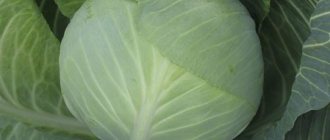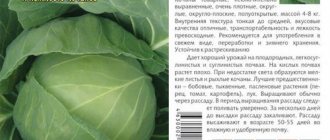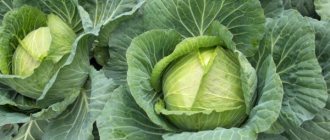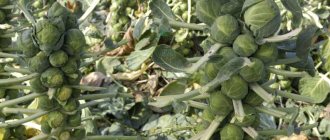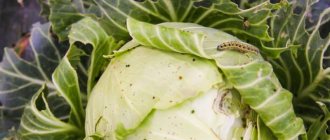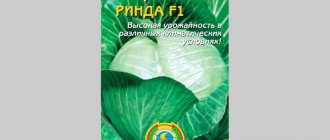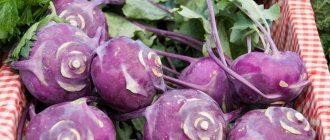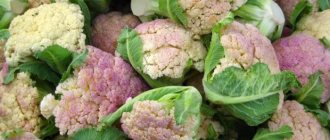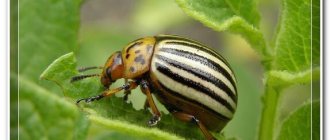Appearance and characteristics of Kolobok cabbage
The maturity of the mid-late hybrid occurs 3.5–4.0 months after planting in the ground.
The vegetable has the following parameters:
- The height of the crop is about 35 cm, the rosette is 45 cm in diameter.
- The leaves look up. The color is dark green on the outside and grayish-white on the back.
- The leaves are round, carved at the edges, wrapped in a pale waxy layer.
- The forks are round and dense, covered with leaves. The weight reaches 4–4.5 kg or more. White in color, with a yellow color on the cut.
- The texture of the fork is juicy, the taste is good, without bitterness.
- The stalk is of medium size with a small stalk.
Kolobok cabbage variety. Appearance
Note! Heads of hybrid cabbage are round in shape. Hence the name - “Kolobok” cabbage.
The Kolobok hybrid is cultivated in open ground and indoors. Since the crop is mid-late, it tolerates the cold season well. Seedlings are well preserved at a thermometer reading of 16 °C and low light levels.
Reviews from experienced gardeners
Gardeners who have already grown and tasted the Kolobok F1 hybrid speak positively about it, noting its good keeping quality and unpretentiousness to the soil and climate.
Anna, Pskov region: “What I like most about this variety is that it keeps well fresh until spring. We keep some of the cabbage in the refrigerator, and some in the basement. Everything is always fine with this variety. You throw away a few of the top leaves, but the middle is always good and of high quality.”
Natalya, Nizhny Novgorod: “ I have been doing gardening for many years. I tried many different varieties of cabbage. Once I saw a photo and read a description of the white cabbage variety Kolobok F1, tried it, and now from year to year I plant this late-ripening cabbage. The heads of cabbage are very dense and are stored until the next harvest. The hybrid is undemanding to soil and weather conditions. It is better to eat this cabbage after the New Year. It’s tough in the fall.”
Advantages and disadvantages
The following positive properties of the hybrid have been revealed:
- Long shelf life of cabbage.
- Convenient transportation over long distances.
- High resistance to frost.
- Excellent presentation.
- Good taste, no bitterness.
- The culture is resistant to diseases and parasitic insects.
Cabbage Kolobok in section
Disadvantages include demands on watering and soil composition. It is moisture that affects the mass and density of the forks. With insufficient watering, crop growth stops. The soil should retain moisture well and contain a large volume of organic matter.
Features of planting Kolobok cabbage
Cabbage is cultivated by seedlings and seeds.
Planting by seeds
Growing cabbage from seeds produces hardy seedlings. Dense and large heads of cabbage grow 10–12 days ahead of schedule.
Seeds are sown in peat pots or directly into the ground. Place 2-3 seeds in each hole. They deepen it by 1 cm. The distance between the holes is 0.7 m. Create a greenhouse and wait for 4–5 leaves to appear.
A large number of seeds are used for sowing, but only healthy and strong shoots are left. The other part is removed during thinning. Therefore, the method is unprofitable for planting.
Growing seedlings
Kolobok cabbage seedlings are planted in the ground in mid-spring. The seeds are sown 50 days before. The soil and planting container are watered with boiling water with the addition of manganese. Wood ash is added to the soil for disinfection and fertilizing.
Cabbage seeds are also disinfected and hardened. They are placed in a gauze bag and immersed in warm water for 20 minutes. Then they are transferred to cold water, and then dried on a napkin.
Growing a Rich Harvest
Many gardeners are interested in the description of Kolobok cabbage. In particular, people are concerned about how to care for Kolobok cabbage, so that the forks in the fall do not upset summer residents, but are pleasing to the eye and a source of pride. In principle, the agricultural technology for growing Kolobok cabbage is the same as for growing any other variety or hybrid of late varieties.
Cabbage must be planted on loamy, fertile soils. Acidic soil will not produce a good harvest. Good light is very important for plant growth. With its deficiency, loose heads of cabbage may form, and the leaves will grow small. The best predecessors will be potatoes, onions, carrots, legumes and cucumbers. You should not plant cabbage in the place where beets, tomatoes and radishes were grown last year, as they have common pests and diseases.
Seeds are sown in early or mid-April. Cabbage will grow better if the distance between the seeds is at least 5 cm. When planting seedlings in the ground, you should adhere to the 60x50 cm seedling pattern. It is important that the air temperature these days has already warmed up to 12-18 degrees. This usually happens in early to mid-May, when 5-6 true leaves have formed. The soil has been prepared since autumn. To do this, it is necessary to fertilize it with lime or dolomite flour. These substances regulate pH levels.
The yield is greatly influenced by hilling, good watering and loosening the soil. Feeding up to 3 times per season is also necessary. Organic and mineral fertilizers are suitable. When increased leaf growth occurs, nitrogen fertilizing is necessary. And when the head is formed - potassium-nitrogen.
When writing a description of Kolobok F1 cabbage, you need to remember the rules of watering. It is important to follow the regime here. The soil should be moistened, but excessive moisture content should not be allowed. This can lead to various diseases and pests. In summer, it is better to water cabbage early in the morning. When the bushes are not yet strong, you need to pour water into the root zone. And mature, formed heads of cabbage can be watered from above. When there are a couple of weeks left before harvesting, watering should be stopped. The heads of cabbage will be dense and will not crack.
Cabbage Kolobok F1 can withstand temperatures not lower than minus 5 degrees. As a rule, cabbage ripens simultaneously and simultaneously; it can be immediately harvested and stored. Main signs of ripening:
- The heads of cabbage should be firm and elastic; their maturity is checked by touch.
- The cessation of mass growth indicates that the heads of cabbage are ripe and need to be harvested, otherwise they may crack.
- You can harvest cabbage as soon as yellowing of the lower leaves is detected.
Kolobok cabbage can be subjected to machine harvesting and long-term transportation. Remember that you need to have time to harvest before heavy frosts. A vegetable that has been exposed to frost will not retain its properties for long.
Proper care
Cabbage roots require oxygen. Therefore, loosening and weeding are carried out after each irrigation. Loose soil provides oxygen access to the root system, which nourishes the cabbage and prevents root rot. At the same time, weeds that feed on beneficial elements are eliminated.
Frequent watering
The soil is watered as it dries. Kolobok cabbage does not welcome drought and dry soil. Therefore, the beds are watered abundantly.
The beds are watered abundantly, as Kolobok does not like drought.
The procedure time is early morning or late evening. The water is warm and settled. Watering is carried out at the root. Liquid calculation: 10 liters per 1 sq. meter.
During the rainy season, irrigation is limited, and before harvesting, the beds are not watered at all for 2 weeks.
Top dressing
Fertilizers are applied three times per season. Both organic and mineral fertilizers are used. The application scheme is as follows:
- After 15 days from planting: nitrogen supplements are added (30 g of urea plus 20 g of saltpeter or 500 ml of mullein per ten liter bucket of water).
- After 10 days, repeat feeding (0.5 liters of chicken manure, 30 g of urea, 0.2 kg of ash per bucket of liquid).
- A week later, the following composition is poured under the root: 20 g of saltpeter, 30 g of superphosphate, 0.5 ml of diluted mullein and a bucket of water.
Note! Dolomite is added to the neutral soil during the growth of Kolobok cabbage.
Description
The kolobok has the following characteristics:
- Good biological and morphological homogeneity.
- Suitable for mechanical cleaning.
- Requirements for the type of soil.
- Vulnerability to water shortages.
- Requirement for fertilizing.
This is a late ripening variety. The full growing season lasts 150-165 days.
The rosette of leaves is semi-raised, compact, up to 30 cm in height and about 45-55 cm in diameter. The leaves are dark green in color and very smooth to the touch. On the surface of the leaves, like other varieties, there is a waxy coating of strong intensity. There is an unexpressed waviness at the edge of the leaf.
The head of cabbage is dense, juicy, round. The diameter of the “head” is 15-20 cm, weight is approximately 3-4 kg. The inside of the head is yellow-white. The outer stump is medium long, the inner one is very short.
Kolobok cabbage is a high-yielding variety. On average, about 85-100 tons of cabbage are harvested from 1 hectare of plantings. Due to its high yield, Kolobok is very popular for growing for sale.
The variety is universal, suitable for fresh and pickled consumption. The harvested crop is stored for a long time, about 7 months. Six months after storage, about 70-75% of the total harvest is suitable for sale on the market. Moreover, it is worth noting that even 6 months after storage, the heads of cabbage have the same juicy and pleasant taste as a vegetable picked from the garden.
When fermented, Kolobok is tasty, but still inferior to many varieties.
Kolobok has average immunity, which partially protects it from diseases such as:
- Fusarium wilt.
- Gray rot.
- White rot.
- Vascular bacteriosis.
- Mucous bacteriosis.
- Alternaria blight.
However, Kolobok is not protected from clubroot and cabbage flies.
The heads of cabbage of this variety are not subject to cracking. The transportability of Kolobok “heads” is at a high level.
Collection and storage
Harvest time is the end of September - the second half of October. Leaving cabbage at a temperature of -5 °C is not recommended. The vegetables are removed in one go, fortunately the cabbage ripens smoothly. The weather chosen is dry. If the weather is humid, the heads of cabbage are dried under a canopy and then transferred to the cellar for storage.
Variety F1 Kolobok is successfully cultivated in private and private farms
Kolobok cabbage is stored at temperatures from −1 °C to +1 °C in a dark room. At humidity 90–95%. Forks are laid out on racks, in boxes, bags, and hung from the ceiling.
Characteristics of Kolobok cabbage and description of the variety were compiled on the basis of long-term observation. And therefore they give a complete picture of the culture and the peculiarities of its cultivation. Due to the ease of cultivation and excellent yield, disease resistance and long-term storage, the hybrid is popular in both personal and farm households.
Beneficial features
It contains large quantities of biotin, rutin, choline, and vitamin K. Micro and macroelements include iron, phosphorus, calcium, sodium, zinc, iodine, honey, selenium, chromium .
Regular consumption of cabbage promotes:
- normalization of digestion;
- prevention of scurvy;
- improving bowel function;
- cleansing the body of toxins;
- prevention of thyroid diseases;
- relieving hangover syndrome;
- breakdown of carbohydrates.
Cabbage juice and leaves are actively used in folk medicine to prevent constipation, hemorrhoids, heal wounds and treat ulcers.
Cabbage juice is actively used in folk medicine
